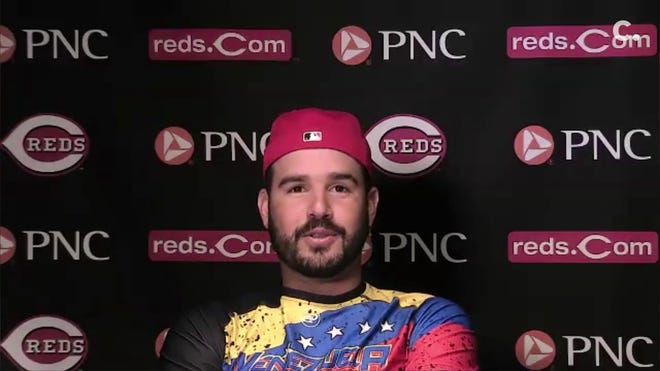
The night before they were both scheduled to pitch for the Daytona Tortugas, the Low-A Minor League affiliate of the Cincinnati Reds, James Proctor and Vincent Timpanelli were going over scouting reports.
Proctor said he felt like he was leaving strikeouts on the table, and he and Timpanelli discussed ways they could change that for the Tortugas’ game on May 23 against the Jupiter Hammerheads.
Then Proctor said, “I feel like we’re going to throw a perfect game tomorrow.”
More:No closer, no problem for the back of the Cincinnati Reds' bullpen
The prediction was nearly spot on, and Daytona had a no-hitter against Jupiter split between Proctor, Timpanelli, Ricky Karcher, Nick Hanson and Carson Spiers.
“You can tell this is definitely a special group of players with a lot of talent,” Timpanelli told The Enquirer.
Four weeks into their season, the Tortugas have one of the best pitching staffs in all of Minor League Baseball. Even though there’s only one of the Reds top-20 prospects in the starting rotation or in the bullpen, Daytona ranks fourth in Minor League Baseball with a 2.74 ERA and ranks ninth in strikeouts per nine innings.
The Reds average 9.84 strikeouts per nine innings this season, and Lucas Sims leads the team with 13.8 strikeouts per nine innings. The entire Tortugas pitching staff averages 12.1 strikeouts per nine innings, and five of their seven top pitchers average 13-or-more.
More:Reds notes: Outfielder Nick Senzel to have knee surgery, miss 4-to-6 weeks
His early success gave Proctor confidence that throwing a no-hitter was plausible.
“Every pitcher is unique, but each type of pitch has metrically speaking outlier qualities,” Tortugas pitching coach Forrest Herrmann said. “That’s what we work to develop with these guys. A lot of these guys possess very unique repertoires relative to the level.”
More:Cincinnati Reds rain delay turns into suspended game, split doubleheader
Aside from Christian Roa, a top-10 prospect for the Reds who has only pitched in one game this season, the Tortugas pitching staff features many overlooked and undrafted pitchers.
More:Jeff Hoffman placed on the injured list. What it means for the Cincinnati Reds' rotation.
Proctor, the ace of the staff early in the season, has a 0.53 ERA in three starts. The Reds signed him as an undrafted free agent from Princeton, where Proctor never had an ERA lower than 4.65.
I definitely flew under the radar, but I was battling through injuries my sophomore and junior years,” Proctor said. “Cincinnati was such a good fit for me because of their emphasis on player development and the investment they’ve made on that side.”
After signing with the Reds, Proctor completely changed his pitch repertoire. He replaced his four-seam fastball with a cutter that became his go-to pitch, added a curveball and changed his slider so it swept more across the strike zone.
The changes are working so far.
“He flipped a switch a week into spring training and has not turned it off,” Herrmann said. “He has a very unique fastball, the way that it moves. He has a very good curveball and slider, and he has zero fear deploying those in any situation.”
Timpanelli took an even more unlikely route to Minor League Baseball. One of the go-to relievers in Daytona’s bullpen, Timpanelli has a 2.35 ERA and a 97 mph fastball.
Two years ago, he was a catcher at Ramapo College of New Jersey, a Division III school. After Timpanelli’s college coach saw him pitch in the low 90s during a bullpen session before his senior year in 2020, Ramapo’s coaching staff gave him a chance to pitch that season.
Two games into the year, Timpanelli’s college baseball season was canceled because of the coronavirus pandemic. During quarantine, he exclusively worked on pitching, and he joined a men’s league to get innings.
A Reds scout saw Timpanelli at one of his games and signed him last August. In 2021, Timpanelli has 13 strikeouts in 7 2/3 innings.
“During the COVID year, we were dialed in with all of our players,” Herrmann said. We created an online community where a significant amount of pitching information was shared, players were trained and got really well prepared. We’re deploying everything we’ve worked on for the last couple years.”

One of the biggest success stories in Daytona so far has been Spiers. He was a two-way player at Clemson who only came out of the bullpen in college. After Spiers went undrafted, the Reds converted him to a starter with the Tortugas.
He earned a call-up to the High-A Dayton Dragons after striking out 27 hitters in 22 2/3 innings.
“They all embrace technology and use it to alter routines, to help maximize their workload and their performance and opportunities on the field,” Herrmann said. “Carson has done an outstanding job with that. He’ll help me prepare the weekly scouting report on the other team.”
Herrmann said he knew that the Tortugas pitching staff could have a great season during Minor League spring training in Arizona. The Reds played Cleveland, their neighbors at the complex in Goodyear, about 20 times in a row.
As the Tortugas pitchers kept having quality appearances, Proctor said the pitchers kept pushing each other to continue to improve.
“We’re all focused on trying to be better than we all were before,” Proctor said. “That led to a situation where everyone is playing really well.”
The Tortugas are the lowest-level minor league team in the Reds organization. Even at that level, the investment the franchise has made in developing pitchers has led to results.
“We’re so aligned as a group from top to bottom,” Herrmann said. “The way that we’ve integrated all the coaches and players in our pitching department, we have such a clear message. We know what we’re trying to accomplish and how we’re going to accomplish that to develop our individual pitchers.”
Source link







